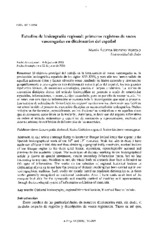Estudios de lexicografía regional: primeros registros de voces vascongadas en diccionarios del español
Autor
Moreno Moreno, María Águeda
Editor
UCOPressFecha
2006Materia
Lexicografía dialectalLéxico histórico regional
Léxico histórico vascongado
Dialectal lexicography
Regional historical lexicón
Historical Basque lexicón
METS:
Mostrar el registro METSPREMIS:
Mostrar el registro PREMISMetadatos
Mostrar el registro completo del ítemResumen
El objetivo principal del trabajo es la localización de voces vascongadas en la producción lexicográfica española de los siglos XVI-XVII, y para ello nos hemos valido de aquellos primeros datos y hemos obtenido corno resultado un léxico marcado y circunscrito geográficamente a esta región en tres diccionarios monolingües del español, los tres grandes repertorios léxicos, de naturaleza etimológica, previos al corpus académico. La técnica de marcación diatópica dentro del artículo lexicográfico se presenta a modo de enunciados especiales, informaciones, si acaso, de tipo secundario, pero no por ello de menor interés. No en vano, con este tipo de información se sustenta toda la investigación que aquí se presenta. Los trabajos de selección de léxico histórico regional en diccionarios claramente nos facilitan ver cómo ha sido el proceso de marcación diatópica en nuestra tradición lexicográfica, Dichos trabajos se fundamentan, especialmente, en los diccionarios académicos o en aquellas obras que se reconocen como hitos en la tradición. Asimismo, se hace uso del soporte informático en orden al método sistemático y especifico de marcación y representación, mediante el sistema arbóreo de exhibición de información de los materiales. In this article I attempt firstly to locate the Basque lexical items that appear in the Spanish lexicographical work of the 16th and 17th centurias. With that aim in mirad I have made use of those initial data and thus obtaining a geographically constraint, marked lexicon of the Basque reglan in the three great lexical repertoires, etymologically oriented and previous to the academic corpus. The technique of diatopic marking in the lexicographical article is shown as special statements, maybe secondary information iteras, but no less interesting in any case. Needless to say, the whole body of research done here is founded on this type of information. The works on the selection of regional historical lexicon in dictionaries allows us to see how the process of diatopic marking has been carried out in our lexicographical tradition. Such works are mostly based on academic dictionaries or in those works generally recognized as tradicional landmarks. Also, I have made avail here of the computerized aids for the systematic and specific method of marking and representation, through the tree-shaped system of information exhibition of materials.

